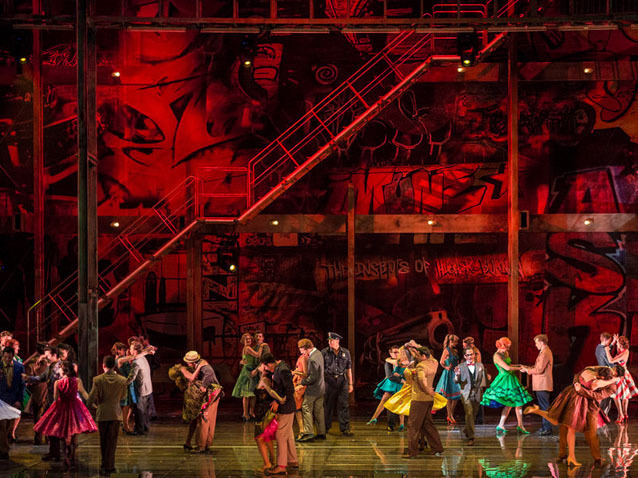 © DR
© DR
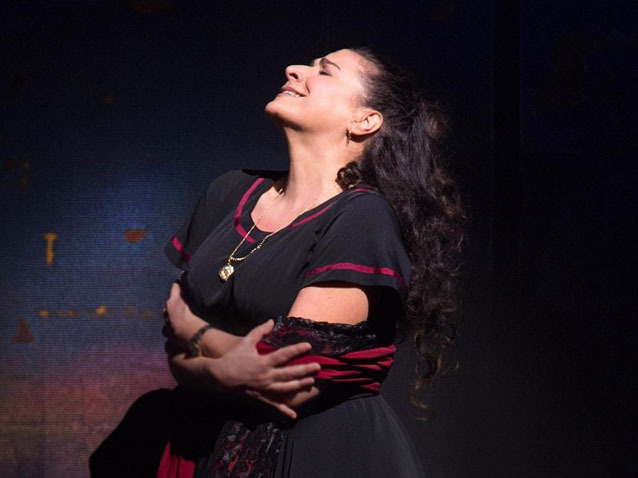
Cecilia Bartoli made it a habit as the artistic director of the Whitsun Festival of Salzburg: for every new edition since 2012, the mezzo-soprano incarnates a female role so that each year is the opportunity to present “a new facet of femininity”. And in order for the 2016 edition to match the 400th anniversary commemoration of William Shakespeare, Cecilia Bartoli chose Romeo and Juliet for this lyrical event.
The author’s piece had obviously already been adapted for the opera (by Gounod or Bellini for instance) but Cecilia Bartoli favored West Side Story, Leornard Berstein’s lyrical drama. A surprising choice at first glance for Salzburg Festival’s lineup, the temple of lyrical art, however it seems to fully find its place in the tradition of lyrical art in order to better confront to modernity.
An in vogue musical work
Initiated as early as 1949 by the choreographer Jerome Robbins and quickly proposed to the librettist Arthur Laurents and to Leonard Bernstein who is in charge of composing the score, the project (called back then East Side Story) aims to be since day one an adaptation of Romeo and Juliet. The trio imagines nevertheless a transposition in post-war New-York, relying on the rivalry of a Catholic family of Italian descent (the Jets) and a Holocaust survivor Jewish family of Manhattan Lower East Side (the Emeralds). This topic, anti-Semitism, had already been exploited numerous times by Broadway at that time and ends up convincing the trio to put the project on hold. We had to wait until 1955 so that the work resumes and draws inspiration from the contemporary events, marked by the increasing of juvenile delinquency and the arising of the gang phenomenon. As Stephen Sondheim is associated to this project as a lyricist, East Side Story becomes West Side Story, still rooted in the poor quarters of New-York working class but this time relying on the confrontation of the Jets, new comers from the European migration (notably Polish) viewing themselves as Americans, and the Sharks, second generation Puerto Rican immigrants. This is why, musically speaking, West Side Story has those recognizable Hispanictones.
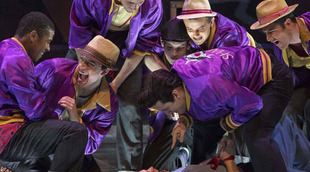
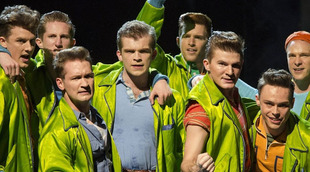
Arthur Laurents’ libretto adapts and transposes pretty faithfully Romeo and Juliette’s outline: Tony, Riff’s close friend, the leader of the Jets, is in love with Maria, Bernardo’s sister, head of the Sharks. A forbidden love, challenged by the pressure of the protagonists’ environment, doomed to a tragic destiny.
West Side Story imposes itself as a major musical work, definitely anchored in the social themes of that time (immigration and racism especially), but still very modern. This contemporaneity probably seduced Cecilia Bartoli. However, at that time, this hybrid approach also jeopardized the realization of the project, considered as too political, too dark or too tragic for some, or reversely being too much of a comedy for others (Arthur Laurents removed some of the texts in order to preserve the intensity of the piece).
It will result from it a very unique piece, conceived as a musical and an entertaining work but claiming also the title of “lyrical drama”, showcasing high musical (and lyrical) ambitions, carried by Leonard Bernstein – sometimes refrained by his collaborators who feared a too harmonious melody for a popular piece but who didn’t prevent him to give an operatic dimension to West Side Story, notably by including some creations initially reserved for Candide, his operetta inspired by Voltaire’s philosophical tale (Tony and Maria’s duo “One hand, one heart” was originally addressed to Cunegonde).
If, all along, West Side Story’s creation had hard time getting funds and being performed (especially because of the difficulty of finding an appropriate casting for this show, that must be “sang, danced and played” at the same time by 17 year old-looking performers), the show was finally played on the 26th of September 1957 in the Winter Garden Theatre of Broadway, with Larry Kert and Carol Lawrence embodying Tony and Maria, and by Chita Rivera in the role of Anita. Then it instantly became a huge popular and critical success. The show will be performed 732 times in Broadway before touring and being played among other places in London in 1958 for more than a thousand performances.
An operatic dimension
Crowned by its success, West Side Story is abundantly covered in different staging, adapted for cinema in 1961 and had been the subject of many versions – notably jazz versions but also an operatic version in 1984 aiming to be recorder (awarded in 1985), arranged and directed by Leonard Bernstein himself for the first time, with Kiri Te Kanawa incarnating Maria, Jose Carreras being Tony and Tatiana Troyanos for Anita. The recording will also be subject of a documentary, The Making of West Side Story, produced by Humphrey Burton and directed by Christopher Swann.
We know that Leonard Bernstein has always aspired to realize “his lyrical version” of West Side Story (according to the composer “the key-word is to tread the fine line between opera and Broadway”) but again, the project raised numerous problems. Leornard Bernstein « always thought of West Side Story in terms of teenagers, and there are no teenage opera singers, it's just a contradiction in terms » (even more a decade ago). « But this is a recording and people don't have to look 16, they don't have to be able to dance or act a rather difficult play eight times a week. And therefore we took this rather unorthodox step of casting number-one world-class opera singers. I suppose the only foreseeable problem was that they might sound too old - but they don't they just sound marvelous! ». The composer pursues: « Kiri singing the part of Maria is a dream. Maria is a Puerto Rican girl and there's a dark color in Kiri's voice, coming from the Maori blood, I suppose, that is deeply moving and just right for this part. And yet when she has to sound girlish and lyrical in the high registers, it's exactly what I want ».
This operatic version of West Side Story is also the opportunity for the composer to rearrange his work in the way he initially imagined it. For the recording, he used therefore a slightly slower tempo than the one played in the scenic versions: “we can take the tempo in which I really dreamed it, which is rather elegant and lyrical”, less heightened but more carried by voices.
Subsequently one can understand better the will of Cecilia Bartoli to create a new production of West Side Story for Salzburg Festival, temple of the lyrical art. The piece lends itself well, echoing the composer’s ambitions and finds a proper place in the contemporary evolution of opera.
West Side Story in Salzburg Festival
For the first time, the Withsun Salzburg Festival opened with a musical, transforming the impressive Felsenreitschule stage (this atypical place, horse-riding arena from the early 17th century with its stoned arcades) in a depiction of the early 50’s New-York, taking the form of a gigantic industrial structure worthy of a Las Vegas blockbuster (we’ve been told before the show that the setting would have required “50 tons of steel, 8 tons of glass and wood and uncountable screws” in order to achieve this transformation). On stage, 47 mesmerizing singers, dancers and comedians are twirling on Jerome Robbins’ original choreography, updated by Liam Steel, and displaying the 270 costumes created by 60 tailors throughout 8000 hours of work.
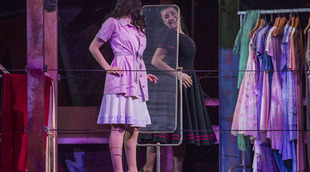
Beautifully outrageous production recalling Broadway’s golden age, but totally fitting the musical standards of Salzburg Festival. In the orchestra pit, the Simón Bolívar Symphony Orchestra of Venezuela is led by the ebullient Gustavo Dudamel (from the Venezuelan Institute El Systema), who at first unleashes his Hispanic roots and his fiery temperament. Then at the whim of the night, one can note the subtle changes of colors, the sound becomes more round and crystalline. And as the dramatic intensity increases, the music overcomes the action as if it was highlighting the absurdity of the behaviors when death and hatred defeat innocent love and the pure beauty of a fierce youth, transcended by the tenor Norman Reinhardt in the role of Tony and Karen Olivo incarnating Anita… in addition of two Maria and not the least.
Because it is undoubtedly one of the originalities of this production: wondering about what’s happening to Maria after Tony’s death. Raising the same questions as Leonard Berstein at the time regarding the age of the characters (teenagers facing teenagers’ issues) but likely to be performed by senior opera singers, the production imagines two performers sharing Maria’s role on stage: Cecilia Bartoli incarnates a Maria remembering her emotions and her childhood memories (underlined by the color, the richness and depth of the mezzo-soprano’s voice), themselves embodied by Michelle Veintimilla (regular on Broadway’s stages) who dances and plays a young idealized Maria.
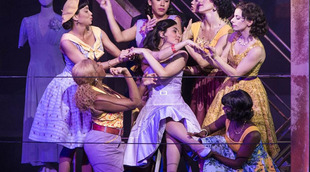
A much significant approach at a time where the opera’s world is mutating. Because, if for a long time the respective places of theater and singing raised animated debates among the “lyricomanes”, it must be concluded that nowadays (at the moments of multimedia productions, video recordings and online or cinema live broadcasts) the scenic performance is more and more linked with vocal qualities of the performers. The actors’ play and the coherence of the roles have an increasing place in the staging and, as an artistic director Cecilia Bartoli seems to embrace this tendency. She imagines a whole show, allowing the right space to the chant and the comedy (even if it means splitting the roles in between to performers) in order to bring out the emotions.
And if this evolution (to which one can agree with or not) seems to shape the future of a new modern operatic kind, maybe we can also perceive a return to the roots. Because the creation of opera itself back in the 17th century, relying on setting antic theater to music, was already aiming to the same goal: creating more entertaining shows, reaching more the emotions thanks to more complete pieces (theatrical, musical, scenic, sometimes real staging prowess for that era, using even special effects) in order to entertain, nay mesmerize the audience. A similar ambition to the one animating the artistic director of Salzburg Festival, and indeed the audience cannot be fooled: at the Whitsun Festival, the spectators offered a standing ovation to this West Side Story and its rerun at the Salzburg summer festival is already sold out.
the 25 of May, 2016 | Print
Comments